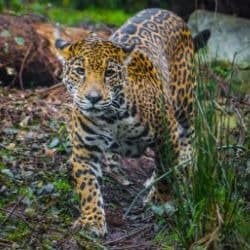News
We bring you the latest from around the World in wildlife and conservation news.
Tourists Come Across Unique Sight Of 200 Polar Bears Feasting On Whale Carcass
A group of people on a boat tour in the far Eastern Russian Arctic didn’t know what they were seeing for a good few minutes until they realised that there were as many as 200 polar bears roaming on the slope of a mountain. The tourists said they were gobsmacked by what can only be described as a completely unique situation. The bears were there to feed on the carcass of a bowhead whale that had washed ashore. After eating their fill, they then rested near the source of their meal. The group of bears included a number of families including a couple of mothers who were being trailed by four cubs each.
Trophy Hunting Could Push Species Into Extinction
A new study suggests that hunters who pick targets that stand out from the crowd because of their lustrous manes or impressive horns could well result in species extinction. The research claims that if hunters remove just 5 per cent of high-quality males, then there is a risk that the entire population could be wiped out given that many species already face intense pressure from a fast-changing world.
Habitat Destruction Bringing Leopards Into Conflict With Humans
Recently a leopard wandered into school building in the Indian state of Assam and ended up mauling four people. Forest officials think that the leopard was simply seeking somewhere to rest for the night before going hunting for prey. Workers doing some construction work entered the school in the morning and four of them were attacked ending up in hospital with everyone surviving.
President Trump’s Border Wall Will Mean The Extinction Of Jaguars In The United States
Wildlife experts and biologists believe that one-day jaguars could make a return to the United States if the country leaves a trail open for females to follow males that have been spotted in the country. There have been seven confirmed male jaguars spotted in the US since 1996. Five of those males ventured into Southern Arizona and two were seen in South-Western New Mexico. Jaguars have effectively been extinct in both places for decades.
Diver Saves Sea Turtle From Choking On Plastic Bag
A diver rescued a sea turtle from certain death after the turtle swallowed a plastic bag that ended up becoming lodged eight inches down the adult female’s throat. Saeed Rashid a lecturer at Bournemouth University was diving in the Red Sea when he came across a couple of Hawksbill turtles that were feeding on jellyfish. After snapping a number of pictures Mr Rashid realised that the female turtle was experiencing some distress and could not feed because the plastic bag was blocking her airway.
Meet The Man Trying To Save The Jaguar
Ricardo Moreno is a cat loving conservationist who has focused his efforts on protecting South America’s biggest cat, the jaguar. The jaguar used to roam across a territory that spanned nearly nine million square kilometres. Its range extended from the Southern mountains of Argentina all the way up to the Grand Canyon in the United States. Unfortunately, after decades of hunting and habitat destruction, the jaguar’s range has dramatically shrunk and in the process its population has fallen by a whopping 40 per cent.
The Strange Tale Of Vladik The Siberian Tiger
About a year ago an endangered Siberian tiger called Vladik terrified residents of Vladivostok, Russia’s Eastern capital as the big cat was frequently spotted just 5 miles away from downtown. People were so afraid that mothers would not even send the children to school in response to the first sighting of a Siberian tiger in the city in over 40 years. In order to ease the panic Vladik was tranquilised and for a while placed in a tiger rehabilitation centre where he was collared and ultimately released nearly 435 miles away in Bikin National Park where there are plenty of deer available to serve as potential prey.
Federal Court Rules To Protect Jaguars In The United States
Jaguars are an endangered species throughout North America and for them borders don’t mean anything, so they aren’t aware whether they are in Mexico or the United States. This means that if the species is to recover there needs to be efforts made on both side of the border. Recently a Federal court in New Mexico recognised this fact when it ruled against an attempt by ranchers and cattle groups who were trying to reverse habitat protections established for the big cats.







